Marvels of Galaxies – Exploring The Cosmos

A galaxy is a system of stars, stellar remnants, interstellar gas, dust, and dark matter bound together by gravity. The word is derived from the Greek galaxias, literally ‘milky’, a reference to the Milky Way galaxy that contains the Solar System. Galaxies, averaging an estimated 100 billion stars, range in size from dwarfs with less than a hundred million stars, to the largest galaxies known supergiants with one hundred trillion stars, each orbiting its galaxy’s center of mass. Most of the mass in a typical galaxy is in the form of dark matter, with only a few percent of that mass visible in the form of stars and nebulae. Supermassive black holes are a common feature at the centres of galaxies.
Galaxies are categorized according to their visual morphology as elliptical, spiral, or irregular. Many are thought to have supermassive black holes at their centers. The Milky Way’s central black hole, known as Sagittarius A, has a mass four million times greater than the Sun.
It is estimated that there are between 200 Billion 7 to 2 Trillion galaxies in the observable universe. Most galaxies are 1,000 to 100,000 parsecs in diameter (Approx 3,000 to 300,000 light years) and are separated by distances on the order of millions of parsecs (or megaparsecs). For comparison, the Milky Way has a diameter of at least 26,800 parsecs (87,400 light year) and is separated from the Andromeda Galaxy (with diameter of about 152,000 light year), its nearest large neighbor, by 780,000 parsecs (2.5 Mil.)
What’s In A Name
The town was a late bloomer.
Smaller towns such as Blair and Oldtown had grown up in Grayson and Carroll counties, and were thriving before Galax was even an idea. Until the early 1900s, there was nothing at all on the wide expanse of meadowland, except Chestnut Creek running through the middle. A stage coach path crossed the property, near the creek, roughly following the modern path of U.S. 58. Other roads began to crisscross the future Galax site, connecting communities in Carroll and Grayson counties. It was known simply as Anderson’s Bottom, and “The Bottom” still lingers as local slang for the low-lying areas of the city east of the creek.
This was the first of five names for the soon-to-be city. It was later known as Montplan, Cairo and Bonaparte before an offhand comment from a railroad executive suggested a new name Galax.
It was the name of the galax plant exported by the ton from forests surrounding the city. Montplan, roughly translated to “mountain plain,” made sense, as did Cairo. Like the Egyptian city near the Nile, the town sprouted beside a body of water. Bonaparte, though, is somewhat of a mystery.
There is no evidence of the name’s origin, and no early settlers by that name. However, in 1906 the year of the city’s founding a man named Charles Bonaparte was the nation’s secretary of the navy.
Etymology
The word galaxy was borrowed via French and Medieval Latin from the Greek term for the Milky Way, galaxías Milky (circle)’, named after its appearance as a milky band of light in the sky. In Greek mythology, Zeus places his son born by a mortal woman, the infant Heracles, on Hera’s breast while she is asleep so the baby will drink her divine milk and thus become immortal. Hera wakes up while breastfeeding and then realizes she is nursing an unknown baby: she pushes the baby away, some of her milk spills, and it produces the band of light known as the Milky Way.
In the astronomical literature, the capitalized word “Galaxy” is often used to refer to the Milky Way galaxy, to distinguish it from the other galaxies in the observable universe.
Observation History
The realization that we live in a galaxy that is one among many parallels major discoveries about the Milky Way and other nebulae.
Milky Way
Greek philosopher Democritus (450 – 370 BCE) proposed that the bright band on the night sky known as the Milky Way might consist of distant stars. Aristotle (384 – 322 BCE), however, believed the Milky Way was caused by “the ignition of the fiery exhalation of some stars that were large, numerous and close together” and that the “ignition takes place in the upper part of the atmosphere, in the region of the World that is continuous with the heavenly motions.” Neoplatonist philosopher Olympiodorus the Younger (c. 495 – 570 CE) was critical of this view, arguing that if the Milky Way was sublunary (situated between Earth and the Moon) it should appear different at different times and places on Earth, and that it should have parallax, which it did not. In his view, the Milky Way was celestial.
According to Mohani Mohamed, Arabian astronomer Ibn al-Haytham (965–1037) made the first attempt at observing and measuring the Milky Way’s parallax, and he thus “determined that because the Milky Way had no parallax, it must be remote from the Earth, not belonging to the atmosphere.” Persian astronomer al-Biruni (973–1048) proposed the Milky Way galaxy was “a collection of countless fragments of the nature of nebulous stars.” Andalusian astronomer Avempace (d. 1138) proposed that it was composed of many stars that almost touched one another, and appeared to be a continuous image due to the effect of refraction from sublunary material, citing his observation of the conjunction of Jupiter and Mars as evidence of this occurring when two objects were near. In the 14th century, Syrian-born Ibn Qayyim al-Jawziyya proposed the Milky Way galaxy was “a myriad of tiny stars packed together in the sphere of the fixed stars.”
Distinction From Other Nebulae
A few galaxies outside the Milky Way are visible on a dark night to the unaided eye, including the Andromeda Galaxy, Large Magellanic Cloud, Small Magellanic Cloud, and the Triangulum Galaxy. In the 10th century, Persian astronomer Abd al-Rahman al-Sufi made the earliest recorded identification of the Andromeda Galaxy, describing it as a “small cloud”. In 964, he probably mentioned the Large Magellanic Cloud in his Book of Fixed Stars (referring to “Al Bakr of the southern Arabs”, since at a declination of about 70° south it was not visible where he lived); it was not well known to Europeans until Magellan’s voyage in the 16th century. The Andromeda Galaxy was later independently noted by Simon Marius in 1612. In 1734, philosopher Emanuel Swedenborg in his Principia speculated that there might be other galaxies outside that were formed into galactic clusters that were minuscule parts of the universe that extended far beyond what could be seen. These views “are remarkably close to the present-day views of the cosmos.” In 1745, Pierre Louis Maupertuis conjectured that some nebula-like objects were collections of stars with unique properties, including a glow exceeding the light its stars produced on their own, and repeated Johannes Hevelius’s view that the bright spots were massive and flattened due to their rotation. In 1750, Thomas Wright correctly speculated that the Milky Way was a flattened disk of stars, and that some of the nebulae visible in the night sky might be separate Milky Ways.
In 1912, Vesto M. Slipher made spectrographic studies of the brightest spiral nebulae to determine their composition. Slipher discovered that the spiral nebulae have high Doppler shifts, indicating that they are moving at a rate exceeding the velocity of the stars he had measured. He found that the majority of these nebulae are moving away from us.
In 1917, Heber Doust Curtis observed nova S Andromedae within the “Great Andromeda Nebula” (as the Andromeda Galaxy, Messier object M31, was then known). Searching the photographic record, he found 11 more novae. Curtis noticed that these novae were, on average, 10 magnitudes fainter than those that occurred within this galaxy. As a result, he was able to come up with a distance estimate of 152,000 parsecs. He became a proponent of the so called “island universes” hypothesis, which holds that spiral nebulae are actually independent galaxies.
Modern Research
In 1944, Hendrik van de Hulst predicted that microwave radiation with wavelength of 21 cm would be detectable from interstellar atomic hydrogen gas; and in 1951 it was observed. This radiation is not affected by dust absorption, and so its Doppler shift can be used to map the motion of the gas in this galaxy. These observations led to the hypothesis of a rotating bar structure in the center of this galaxy. With improved radio telescopes, hydrogen gas could also be traced in other galaxies. In the 1970s, Vera Rubin uncovered a discrepancy between observed galactic rotation speed and that predicted by the visible mass of stars and gas. Today, the galaxy rotation problem is thought to be explained by the presence of large quantities of unseen dark matter.
A 2016 study published in The Astrophysical Journal, led by Christopher Conselice of the University of Nottingham, used 20 years of Hubble images to estimate that the observable universe contained at least two trillion (2×1011) galaxies. However, later observations with the New Horizons space probe from outside the zodiacal light reduced this to roughly 210 billion (2×1010).
Types of Galaxy

Galaxies come in three main types: ellipticals, spirals, and irregulars. A slightly more extensive description of galaxy types based on their appearance is given by the Hubble sequence. Since the Hubble sequence is entirely based upon visual morphological type (shape), it may miss certain important characteristics of galaxies such as star formation rate in starburst galaxies and activity in the cores of active galaxies.
Ellipticals

The Hubble classification system rates elliptical galaxies on the basis of their ellipticity, ranging from E0, being nearly spherical, up to E7, which is highly elongated. These galaxies have an ellipsoidal profile, giving them an elliptical appearance regardless of the viewing angle. Their appearance shows little structure and they typically have relatively little interstellar matter. Consequently, these galaxies also have a low portion of open clusters and a reduced rate of new star formation. Instead, they are dominated by generally older, more evolved stars that are orbiting the common center of gravity in random directions.
Type CD Galaxies
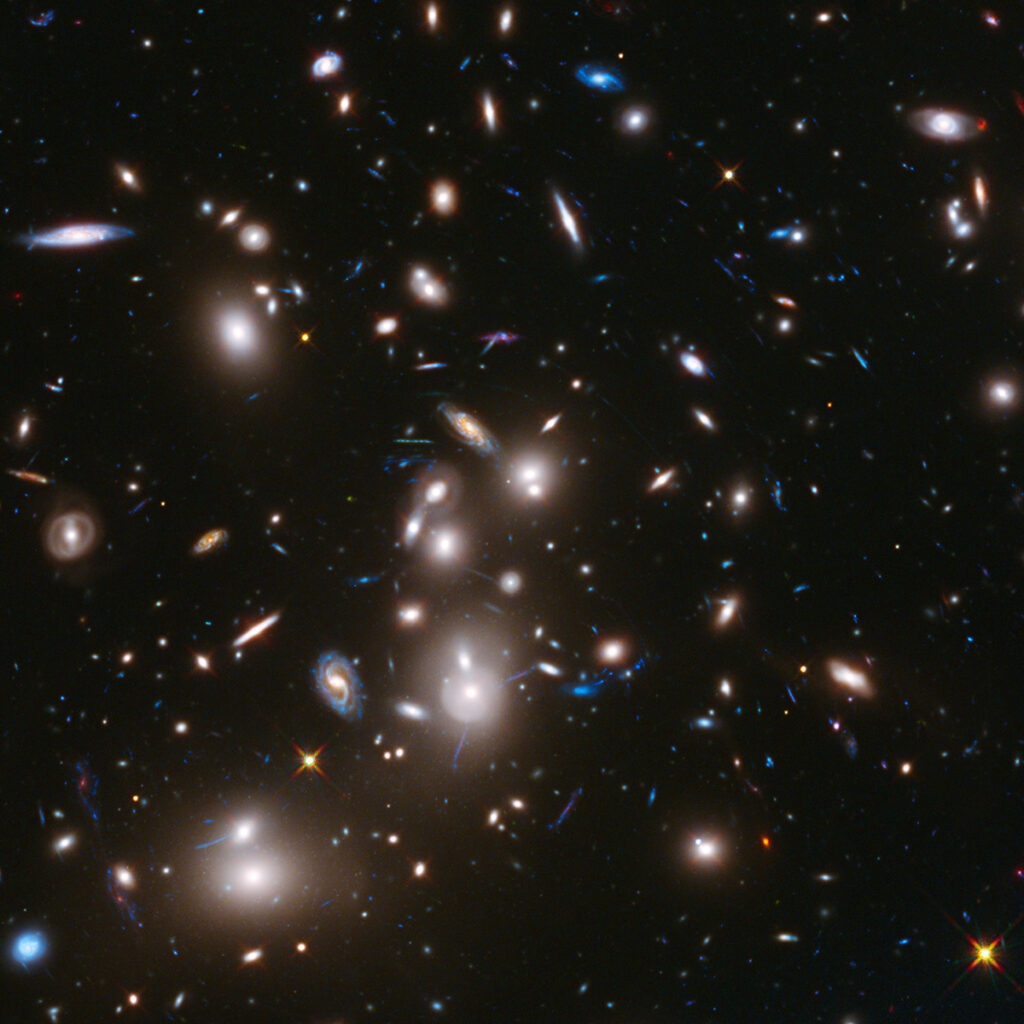
The largest galaxies are the type-cD galaxies. First described in 1964 by a paper by Thomas A. Matthews and others, they are a subtype of the more general class of D galaxies, which are giant elliptical galaxies, except that they are much larger. They are popularly known as the supergiant elliptical galaxies and constitute the largest and most luminous galaxies known. These galaxies feature a central elliptical nucleus with an extensive, faint halo of stars extending to megaparsec scales. The profile of their surface brightness as a function of their radius (or distance from their cores) falls off more slowly than their smaller counterparts.
The formation of these cD galaxies remains an active area of research, but the leading model is that they are the result of the mergers of smaller galaxies in the environments of dense clusters, or even those outside of clusters with random overdensities.
Shell Galaxy

A shell galaxy is a type of elliptical galaxy where the stars in its halo are arranged in concentric shells. About one-tenth of elliptical galaxies have a shell like structure, which has never been observed in spiral galaxies. These structures are thought to develop when a larger galaxy absorbs a smaller companion galaxy that as the two galaxy centers approach, they start to oscillate around a center point, and the oscillation creates gravitational ripples forming the shells of stars, similar to ripples spreading on water. For example, galaxy NGC 3923 has over 20 shells.
Spirals Galaxy

Spiral galaxies resemble spiraling pinwheels. Though the stars and other visible material contained in such a galaxy lie mostly on a plane, the majority of mass in spiral galaxies exists in a roughly spherical halo of dark matter which extends beyond the visible component, as demonstrated by the universal rotation curve concept.
Spiral galaxies consist of a rotating disk of stars and interstellar medium, along with a central bulge of generally older stars. Extending outward from the bulge are relatively bright arms. In the Hubble classification scheme, spiral galaxies are listed as type S, followed by a letter (a, b, or c) which indicates the degree of tightness of the spiral arms and the size of the central bulge. An Sa galaxy has tightly wound, poorly defined arms and possesses a relatively large core region. At the other extreme, an galaxy has open, well-defined arms and a small core region. A galaxy with poorly defined arms is sometimes referred to as a flocculent spiral galaxy; in contrast to the grand design spiral galaxy that has prominent and well-defined spiral arms. The speed in which a galaxy rotates is thought to correlate with the flatness of the disc as some spiral galaxies have thick bulges, while others are thin and dense.
Barred Spiral Galaxy

A majority of spiral galaxies, including the Milky Way galaxy, have a linear, bar-shaped band of stars that extends outward to either side of the core, then merges into the spiral arm structure. In the Hubble classification scheme, these are designated by an SB, followed by a lower-case letter (a, b or c) which indicates the form of the spiral arms (in the same manner as the categorization of normal spiral galaxies). Bars are thought to be temporary structures that can occur as a result of a density wave radiating outward from the core, or else due to a tidal interaction with another galaxy. Many barred spiral galaxies are active, possibly as a result of gas being channeled into the core along the arms.
Our own galaxy, the Milky Way, is a large disk-shaped barred-spiral galaxy about 30 kiloparsecs in diameter and a kiloparsec thick.
Super Luminous Spiral Galaxy
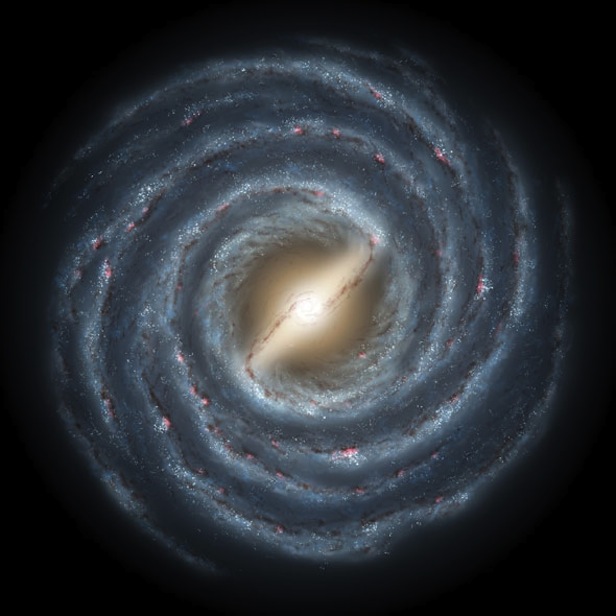
Recently, researchers described galaxies called super-luminous spirals. They are very large with an upward diameter of 437,500 light years (compared to the Milky Way’s 87,400 light-year diameter).
With a mass of 340 billion solar masses, they generate a significant amount of ultraviolet and mid-infrared light. They are thought to have an increased star formation rate around 31 times faster than the Milky Way.
Variants of the Galaxies
Interacting

Interactions between galaxies are relatively frequent, and they can play an important role in galactic evolution. Near misses between galaxies result in warping distortions due to tidal interactions, and may cause some exchange of gas and dust. Collisions occur when two galaxies pass directly through each other and have sufficient relative momentum not to merge. The stars of interacting galaxies usually do not collide, but the gas and dust within the two forms interacts, sometimes triggering star formation. A collision can severely distort the galaxies’ shapes, forming bars, rings or tail-like structures.
At the extreme of interactions are galactic mergers, where the galaxies’ relative momentums are insufficient to allow them to pass through each other. Instead, they gradually merge to form a single, larger galaxy. Mergers can result in significant changes to the galaxies’ original morphology. If one of the galaxies is much more massive than the other, the result is known as cannibalism, where the more massive larger galaxy remains relatively undisturbed, and the smaller one is torn apart.
Starburst
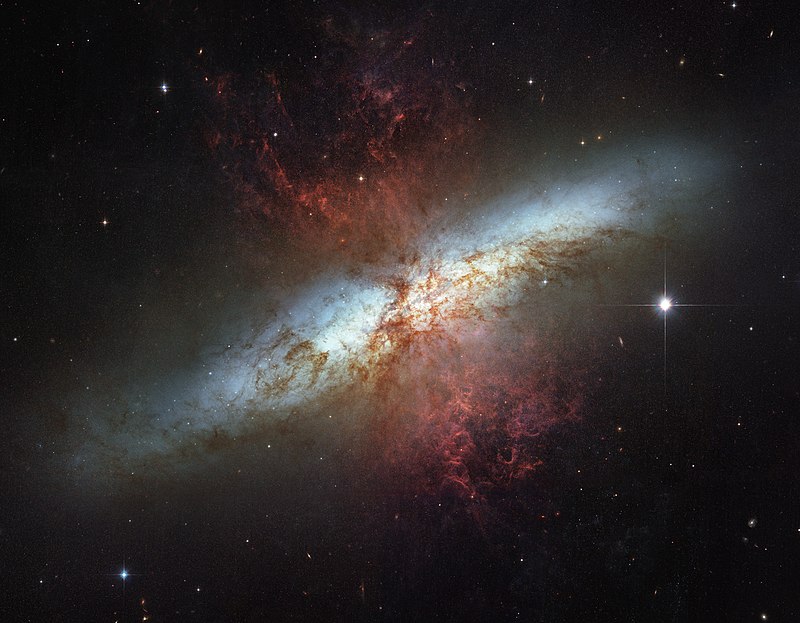
Stars are created within galaxies from a reserve of cold gas that forms giant molecular clouds. Some galaxies have been observed to form stars at an exceptional rate, which is known as a starburst. If they continue to do so, they would consume their reserve of gas in a time span less than the galaxy’s lifespan. Hence starburst activity usually lasts only about ten million years, a relatively brief period in a galaxy’s history. Starburst galaxies were more common during the universe’s early history, but still contribute an estimated 14.5% to total star production.
Starburst galaxies are characterized by dusty concentrations of gas and the appearance of newly formed stars, including massive stars that ionize the surrounding clouds to create H II regions. These stars produce supernova explosions, creating expanding remnants that interact powerfully with the surrounding gas.
Radio Galaxy
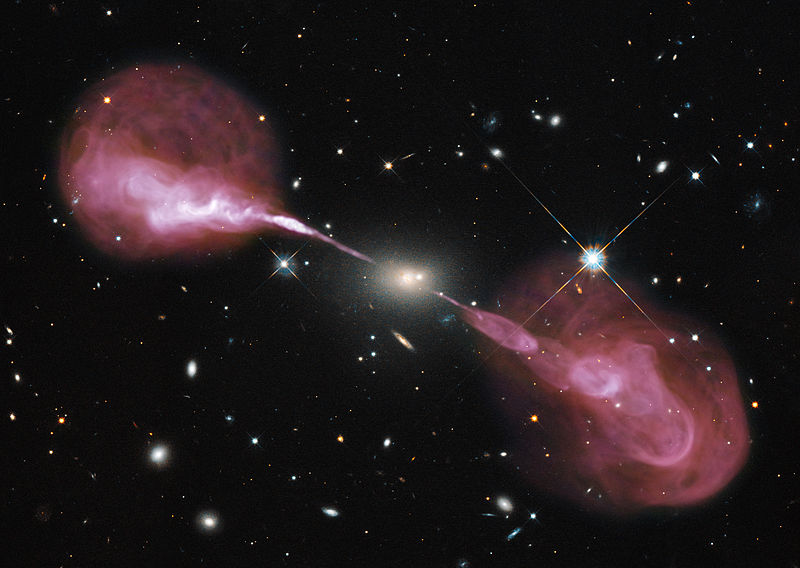
Radio galaxies can also be classified as giant radio galaxies (GRGs), whose radio emissions can extend to scales of megaparsecs (3.27 Mil light years). Alcyoneus is an FR II class low-excitation radio galaxy which has the largest observed radio emission, with lobed structures spanning 5 megaparsecs (16×106 light year). For comparison, another similarly sized giant radio galaxy is 3C 237, with lobes 15 million light-years across. It should however be noted that radio emissions are not always considered part of the main galaxy itself, and is usually not used as a standard in measuring the physical diameter of a galaxy. For insight on how physical diameters of galaxies are measured, see section Physical diameters below.
Active Galaxy
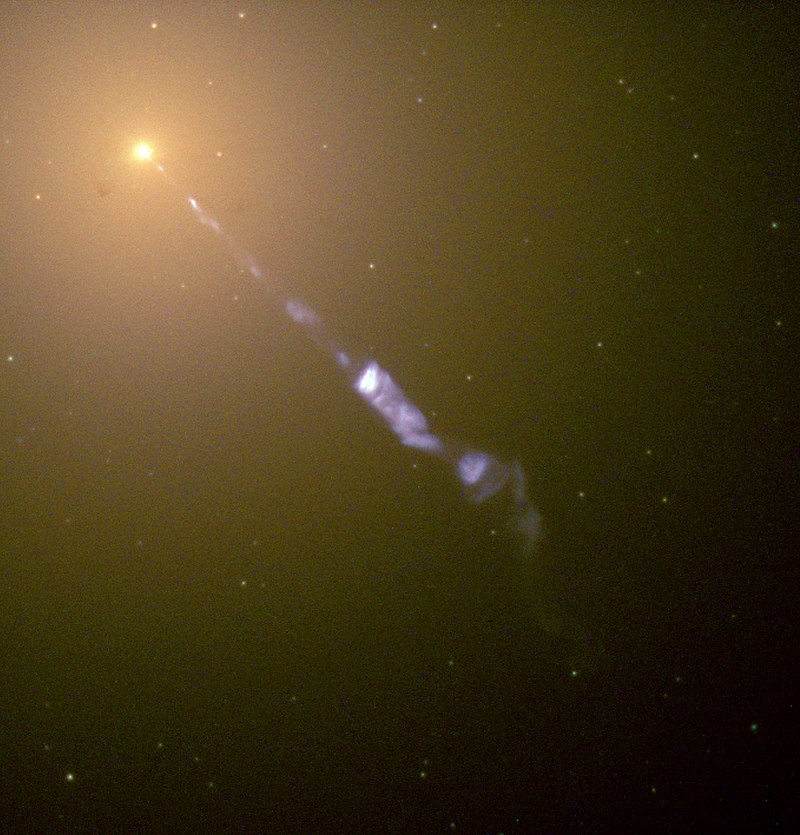
Some observable galaxies are classified as “active” if they contain an active galactic nucleus (AGN). A significant portion of the galaxy’s total energy output is emitted by the active nucleus instead of its stars, dust and interstellar medium. There are multiple classification and naming schemes for AGNs, but those in the lower ranges of luminosity are called Seyfert galaxies, while those with luminosities much greater than that of the host galaxy are known as quasi-stellar objects or quasars. AGNs emit radiation throughout the electromagnetic spectrum from radio wavelengths to X-rays, though some of it may be absorbed by dust or gas associated with the AGN itself or with the host galaxy.
Physical Diameters

Galaxies do not have a definite boundary by their nature, and are characterized by a gradually decreasing stellar density as a function of increasing distance from their center, making measurements of their true extents difficult. Nevertheless, astronomers over the past few decades have made several criteria in defining the sizes of galaxies. As early as the time of Edwin Hubble in 1936, there have been attempts to characterize the diameters of galaxies. With the advent of large sky surveys in the second half of the 20th century, the need for a standard for accurate determination of galaxy sizes has been in greater demand due to its enormous implications in astrophysics, such as the accurate determination of the Hubble constant. Various standards have been adapted over the decades, some more preferred than others. Below are some of these examples.
Isophotal Diameter
The isophotal diameter is introduced as a conventional way of measuring a galaxy’s size based on its apparent surface brightness. Isophotes are curves in a diagram – such as a picture of a galaxy – that adjoins points of equal brightnesses, and are useful in defining the extent of the galaxy. The apparent brightness flux of a galaxy is measured in units of magnitudes per square arcsecond (mag/arcsec2; sometimes expressed as mag arcsec 2), which defines the brightness depth of the isophote. To illustrate how this unit works, a typical galaxy has a brightness flux of 18 mag/arcsec2 at its central region. This brightness is equivalent to the light of an 18th magnitude hypothetical point object (like a star) being spread out evenly in a one square arcsecond area of the sky. For the purposes of objectivity, the spectrum of light being used is sometimes also given in figures. As an example, the Milky Way has an average surface brightness of 22.2 B mag / arcsec 2, where B-mag refers to the brightness at the B band (455 nm wavelength of light, in the blue part of the visible spectrum).
Formation
Current models of the formation of galaxies in the early universe are based on the ΛCDM model. About 300,000 years after the big bang, atoms of hydrogen and helium began to form, in an event called recombination. Nearly all the hydrogen was neutral (non-ionized) and readily absorbed light, and no stars had yet formed. As a result, this period has been called the “dark ages”. It was from density fluctuations (or anisotropic irregularities) in this primordial matter that larger structures began to appear. As a result, masses of baryonic matter started to condense within cold dark matter halos. These primordial structures eventually became the galaxies we see today.
Multi Wavelength
The dust present in the interstellar medium is opaque to visual light. It is more transparent to far-infrared, which can be used to observe the interior regions of giant molecular clouds and galactic cores in great detail. Infrared is also used to observe distant, red-shifted galaxies that were formed much earlier. Water vapor and carbon dioxide absorb a number of useful portions of the infrared spectrum, so high-altitude or space-based telescopes are used for infrared astronomy.
The first non-visual study of galaxies, particularly active galaxies, was made using radio frequencies. The Earth’s atmosphere is nearly transparent to radio between 5 MHz and 30 GHz. (The ionosphere blocks signals below this range.) Large radio interferometers have been used to map the active jets emitted from active nuclei. Radio telescopes can also be used to observe neutral hydrogen (via 21 cm radiation), including, potentially, the non-ionized matter in the early universe that later collapsed to form galaxies.








